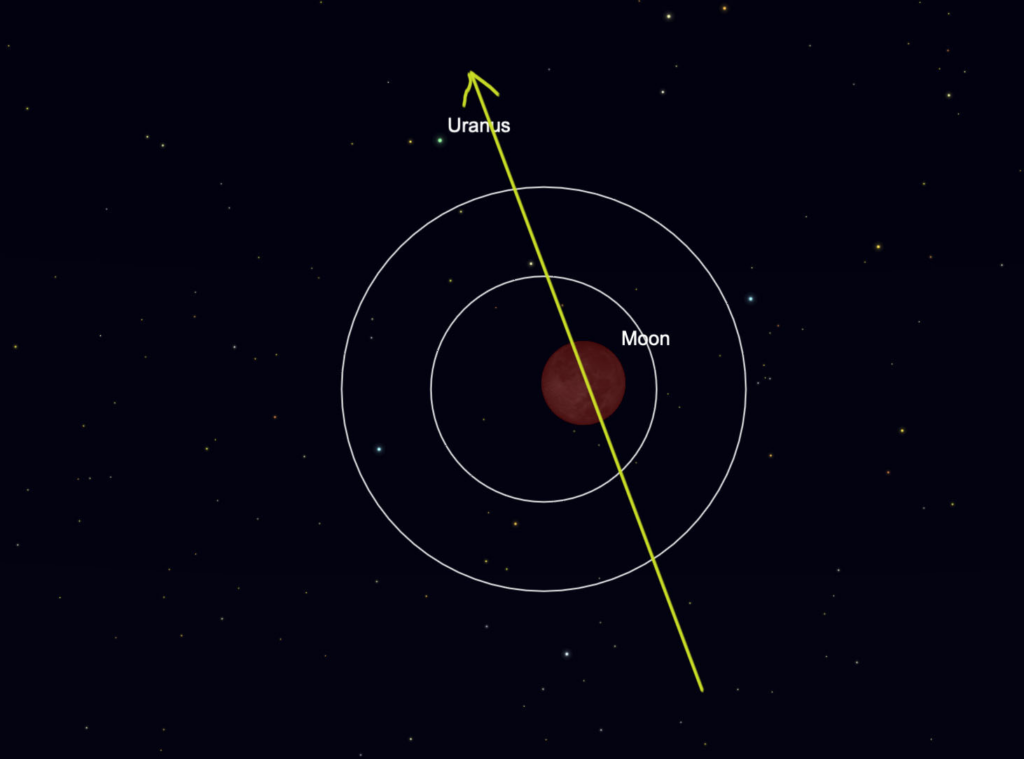Sky Report: November 7-13

The moon at mid-eclipse at 3:49 MST with the outlines of the earth’s penumbra and umbra, stars of Aries, and Uranus. The moon’s motion is from lower right to upper left. The width of the rectangle is 6°. Graphic created with SkySafariAstronomy.com.
The highlight this week is a total eclipse of the moon, the second this year since the total eclipse on May 16. That eclipse happened in the early evening on a warm night and was widely observed; this eclipse happens early on the morning of Tuesday, November 8, when it is downright chilly, and it will attract less attention.
A total lunar eclipse happens when the moon moves through the inner, darkest part of the earth’s shadow, and it takes place in stages over several hours. The eclipse begins when the moon enters the penumbra, the outer part of the earth’s shadow, at 1:01 a.m., but the shading is far too subtle to notice. Beginning at 2:09 MST the upper left edge of the moon enters the umbra and begins to darken. The interesting part of the eclipse is from 3:16 to 4:42 when the moon is wholly with the earth’s shadow and the eclipse is total. These times are the same throughout the USA (adjust the time zone where necessary.)
The difference between the two parts of the shadow is this: if you were standing on the moon in the penumbra you would see the earth partially block the sun; if you were in the umbra the earth completely blocks the sun (and seen from earth the eclipse is total).
The best way to observe the eclipse is to set an alarm for the middle of the eclipse, at around 4 a.m. MST, and step outside with binoculars. The moon is a third of the way up the western sky. Note especially the reddish color of the eclipsed moon and the faint outlines of the lunar seas.
The moon is in Aries, the Ram, and you’ll see the three brightest stars of Aries to the lower right of the moon while the grand winter constellations Orion, Taurus, Canis Major, Gemini, and others, are to the upper left of the moon. The orange planet Mars is 40° above the moon at the 11 o’clock position. And the planet Uranus is less than 2° from the moon at the 11 o’clock position – in line with the moon and Mars — and you can easily see Uranus as a faint “star” with the same binoculars you use to observe the eclipse.
Google “eclipse November 2022” for much additional information.
Enjoy this one because the next total lunar eclipse won’t happen until March 14, 2025.
Turning to the other planets, Jupiter is due south and half-way up the sky at about 9 p.m. At the same time Saturn is half as high and 1/5 as bright in the southwest. Both have set before the eclipse.
On the 10th Mars is 9° straight below the moon and on the 11th Mars is 9° to the upper right of the moon. Watch both nights to see one-day’s-worth of motion of the gibbous moon.
Next week: the annual Leonid Meteor Shower may be worth watching. Stay tuned.
Stellar Vista Observatory provides portable telescopes and tripod mounted binocular kits on loan for free to residents and visitors in Kane County. Enhance your enjoyment of the night sky! For details or to request a loan, visit https://stellarvistaobservatory.org/discover-the-night-sky/ or drop in to the Kane County Office of Tourism.
The Sky Report is presented as a public service by the Stellar Vista Observatory, a nonprofit organization based in Kanab, Utah, which provides opportunities for people to observe, appreciate, and comprehend our starry night sky. Additional information is at www.stellarvistaobservatory.org. Send questions and comments to John@StargazingAdventures.org.
John Mosley was Program Supervisor of the Griffith Observatory in Los Angeles for 27 years and is the author of “Stargazing for Beginners” and “Stargazing with Binoculars and Telescopes”. He and his wife live in St. George where he continues to stargaze from his retirement home while serving on the advisory committee for Stellar Vista Observatory.






Comments are closed.